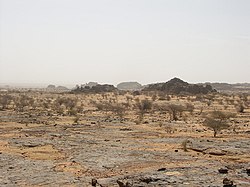Aoukar
Aoukar
عوكر | |
|---|---|
 Landscape in the Ayoun el Atrous area | |
 Location of the Aoukar basin in Mauritania | |
| Country | Mauritania |
| Elevation | 240 m (790 ft) |
Aoukar or Erg Aoukar[1] (Arabic: عوكر) is a geological depression area of south eastern Mauritania. It is located between Kiffa and Néma, south of the Tagant Plateau.
The Aoukar basin is a dry natural region of sand dunes and salt pans fringed by escarpments on its northern and eastern sides.
History[]
There was once vast reed-covered endorheic lake in the area, but it no longer exists. The former lake of Aoukar extended towards the area of Tichit, bordering the southern edge of the Tagant Plateau. Below the cliffs (dhars) facing the extinct lake remains of about 400 villages have been found.[2][3]
From east to west, Dhar Néma, Dhar Walata, Dhar Tichitt, and Dhar Tagant form a semicircular shape around the Hodh/Aoukar Depression, which, prior to 4000 BCE, was an area with lakes of considerable size, and, after 1000 BCE, was an area that had become increasingly dried.[4] During the emergence of the Tichitt Tradition, it was an oasis area.[4] The Tichitt Tradition of eastern Mauritania dates from 2200 BCE[5][6] to 200 BCE.[7][8]
Ecology[]
The Aoukar is one of the few natural refuges for the addax, a critically endangered kind of antelope which lives in the region.[9]
See also[]
- Geography of Mauritania
- List of ergs
References[]
- ^ Marco Stoppato, Alfredo Bini (2003), Deserts, p. 156
- ^ Tichit - The living ghost of yesterday's glory
- ^ G. Marcus and B. de Valicourt (2000). Mauritanie, p. 10
- ^ a b MacDonald, Kevin C.; Vernet, Robert; Martinon-Torres, Marcos; Fuller, Dorian Q. "Dhar Néma: From early agriculture to metallurgy in southeastern Mauritania". ResearchGate. Azania Archaeological Research in Africa.
- ^ McDougall, E. Ann (2019). "Saharan Peoples and Societies". Oxford Research Encyclopedia of African History. Oxford Research Encyclopedias. Oxford Research Encyclopedias. doi:10.1093/acrefore/9780190277734.013.285. ISBN 978-0-19-027773-4.
- ^ Holl, Augustin F.C. "Coping with uncertainty: Neolithic life in the Dhar Tichitt-Walata, Mauritania, (ca. 4000–2300 BP)". ScienceDirect. Comptes Rendus Geoscience.
- ^ MacDonald, K.; Vernet, R. (2007). Early domesticated pearl millet in Dhar Nema (Mauritania): evidence of crop processing waste as ceramic temper. Netherlands: Barkhuis. pp. 71–76. ISBN 9789077922309.
- ^ Kay, Andrea U. (2019). "Diversification, Intensification and Specialization: Changing Land Use in Western Africa from 1800 BC to AD 1500". Journal of World Prehistory. 32 (2): 179–228. doi:10.1007/s10963-019-09131-2. S2CID 134223231.
- ^ Richard Trillo, The Rough Guide to West Africa
External links[]
- Landforms of Mauritania
- Depressions (geology)
- Endorheic basins of Africa
- Geology of Mauritania
- Sedimentary basins of Africa
- Natural regions of Africa
- Mauritania geography stubs
